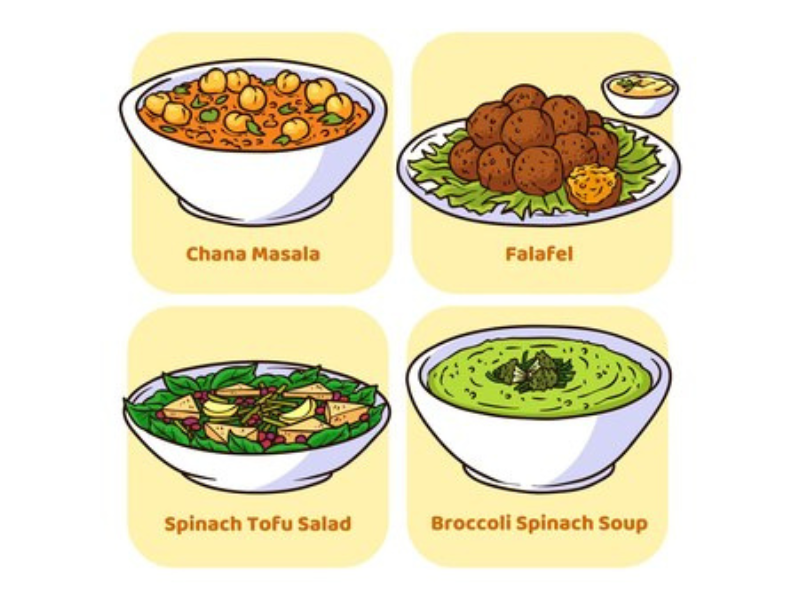Arab cuisine is one of the most diverse and flavorful in the world, with a wide range of dishes and flavors that reflect the rich history and culture of the Arab world. From the comforting warmth of a bowl of piping hot lentil soup to the bold spices of a plate of grilled lamb kebabs, Arab cuisine offers a culinary journey like no other. In this article, we will explore the breadth and depth of Arab cuisine, from the iconic hummus to the mouth-watering shawarma.
1. Introduction to Arab Cuisine
Arab cuisine encompasses the traditional foods and dishes of the Arab world, which includes the countries of the Arabian Peninsula, the Levant, North Africa, and parts of the Mediterranean. These regions have a long history of trade and cultural exchange, which have influenced the flavors and ingredients used in their cuisine.
2. The Importance of Hospitality in Arab Cuisine
Hospitality is a central tenet of Arab culture, and this is reflected in their cuisine. Meals are often shared with family and friends, and guests are treated with generosity and warmth. This emphasis on hospitality is evident in the abundance of food served at gatherings and the tradition of serving multiple dishes to ensure guests’ satisfaction.
3. The Staple Foods of Arab Cuisine
Rice, bread, and lamb are staple foods in Arab cuisine, and they form the foundation of many traditional dishes. Rice is often served alongside stews and meats, while flatbreads like pita and lavash are used to scoop up dips and spreads like hummus and baba ghanoush.
4. The Iconic Dish: Hummus
Hummus is perhaps the most well-known dish in Arab cuisine, a creamy blend of chickpeas, tahini, lemon juice, and garlic. It is typically served as a dip with pita bread or as an accompaniment to grilled meats and kebabs. Hummus is a versatile dish that can be flavored in a variety of ways, such as with roasted red peppers, pine nuts, or herbs.
5. The Aromatic Spices of Arab Cuisine
Arab cuisine is known for its bold and aromatic spices, which add depth and flavor to dishes. Common spices used in Arab cuisine include cumin, coriander, cinnamon, and sumac, which lend a warm and earthy flavor profile to dishes. These spices are often used in blends like baharat and za’atar, which are essential seasonings in Arab cooking.
6. The Technique of Grilling in Arab Cuisine
Grilling is a popular cooking technique in Arab cuisine, with meats like lamb, chicken, and beef being marinated in flavorful spices and grilled over open flames. The smoky charred flavor of grilled meats is a hallmark of Arab cuisine, and dishes like shish kebabs, kofta, and shawarma showcase this technique.

7. The Vegetarian Delights of Arab Cuisine
While Arab cuisine is known for its grilled meats and kebabs, there are also a variety of vegetarian dishes that are equally flavorful and satisfying. Dishes like falafel, tabbouleh, and fattoush are popular vegetarian options that showcase the freshness and vibrancy of Arab cuisine.
8. The Sweet Treats of Arab Cuisine
Arab cuisine is renowned for its array of sweet treats and desserts, which are often rich and indulgent. Baklava, a flaky pastry filled with nuts and honey, is a beloved dessert in Arab cuisine, as are semolina cakes like basbousa and rosewater-scented puddings like muhallabia.
9. From Street Food to Fine Dining: The Range of Arab Cuisine
Arab cuisine encompasses a wide range of dining options, from casual street food stalls serving shawarma and falafel to upscale restaurants offering traditional dishes with a modern twist. Whether dining in a bustling bazaar or a Michelin-starred restaurant, the flavors and aromas of Arab cuisine are sure to tantalize the taste buds.
10. Regional Variations in Arab Cuisine
Each region of the Arab world has its own culinary traditions and specialties, influenced by local ingredients and cultural influences. For example, North African cuisine is characterized by the use of couscous, preserved lemons, and spicy harissa, while Levantine cuisine features dishes like fattoush salad, manakish flatbreads, and kibbeh.
11. The Role of Food in Arab Celebrations and Festivals
Food plays a central role in Arab celebrations and festivals, with feasts and gatherings centered around traditional dishes and delicacies. During holidays like Eid al-Fitr and Ramadan, families come together to share special meals and sweets, creating lasting memories and strengthening bonds.
12. The Global Influence of Arab Cuisine
Arab cuisine has gained popularity around the world, thanks to the growing interest in Middle Eastern flavors and ingredients. Dishes like hummus, falafel, and shawarma can now be found on menus in restaurants and grocery stores worldwide, showcasing the versatility and appeal of Arab cuisine.
13. The Future of Arab Cuisine
As Arab cuisine continues to evolve and adapt to changing tastes and preferences, chefs and food enthusiasts are exploring new flavor combinations and techniques to showcase the diversity of Arab cooking. With a renewed focus on fresh, seasonal ingredients and sustainability, Arab cuisine is poised to inspire and delight food lovers for years to come.
14. Conclusion: Exploring the Richness of Arab Cuisine
From the creamy richness of hummus to the succulent flavors of shawarma, Arab cuisine offers a culinary journey like no other. With its bold spices, aromatic herbs, and rich history, Arab cuisine is a vibrant and flavorful tapestry that reflects the diversity and complexity of the Arab world. Whether enjoying a simple meal with family or indulging in a lavish feast, the flavors and aromas of Arab cuisine are sure to captivate and delight the senses.
FAQs about “From Hummus to Shawarma: A Culinary Journey through Arab Cuisine”
- What makes “From Hummus to Shawarma: A Culinary Journey through Arab Cuisine” an enticing exploration of Arab food? “From Hummus to Shawarma” offers a captivating journey through the diverse flavors and traditions of Arab cuisine. It showcases iconic dishes and lesser-known gems, providing readers with a comprehensive understanding of the culinary heritage of the Arab world.
- Which Arab cuisines are covered in this culinary journey? This book covers a wide range of Arab cuisines, including Lebanese, Syrian, Palestinian, Jordanian, Egyptian, and more. Each cuisine is celebrated for its unique flavors, ingredients, and culinary techniques.
- Are specific Arab dishes featured in this culinary exploration? Yes, “From Hummus to Shawarma” features a curated selection of classic Arab dishes, such as hummus, falafel, tabbouleh, kibbeh, shawarma, and more. Each dish is accompanied by background information, cultural insights, and tips for preparing it authentically.
- How does this book delve into the cultural heritage of Arab cuisine? This book delves into the cultural heritage of Arab cuisine by exploring its origins, influences, and significance in Arab society. Readers will learn about the historical and cultural context of Arab dishes, as well as the traditions and customs associated with Arab culinary customs.
- Can readers expect to gain insights into the regional variations of Arab cuisine in this book? Absolutely! “From Hummus to Shawarma” celebrates the regional diversity of Arab cuisine by featuring dishes from different countries and regions. From the spice-infused dishes of the Levant to the fragrant stews of North Africa, readers will discover the distinct flavors and culinary traditions of each region.
Advantages:
- Evocative language: The title “From Hummus to Shawarma: A Culinary Journey through Arab Cuisine” uses descriptive terms to evoke the richness and diversity of Arab culinary traditions, immediately capturing the reader’s interest.
- Cultural immersion: The title suggests a journey through Arab culinary heritage, offering readers insights into the culture, history, and flavors of the Arab world.
- Gastronomic exploration: Readers can anticipate discovering a variety of Arab dishes, from hummus to shawarma, providing them with a comprehensive overview of the diverse culinary landscape of the Arab world.
- Practicality: By focusing on Arab cuisine, the title appeals to readers interested in exploring authentic and delicious Middle Eastern dishes, providing them with recipes, tips, and techniques.
- Inspiration for cooking: The title may inspire readers to try cooking Arab dishes at home, offering them practical insights and recipes to recreate the flavors of the Arab world in their own kitchens.
Disadvantages:
- Lack of specificity: While hummus and shawarma are mentioned, the title does not specify which other dishes will be explored or which regions of the Arab world will be covered, leaving readers uncertain about the scope of the content.
- Potential oversimplification: Focusing solely on hummus and shawarma may oversimplify the richness and diversity of Arab culinary traditions, overlooking other cultural and regional specialties.
- Dietary restrictions: While Arab cuisine is generally healthy, some dishes may not be suitable for individuals with dietary restrictions or preferences, potentially alienating some readers.
- Cultural appropriation: Without proper context and understanding, celebrating Arab cuisine could risk appropriating cultural elements without acknowledging their significance or respecting their origins.
- Accessibility of ingredients: Some Arab dishes may require specific ingredients that are difficult to find outside of the Arab world or major culinary hubs, limiting the practicality of the recipes for some readers.
















